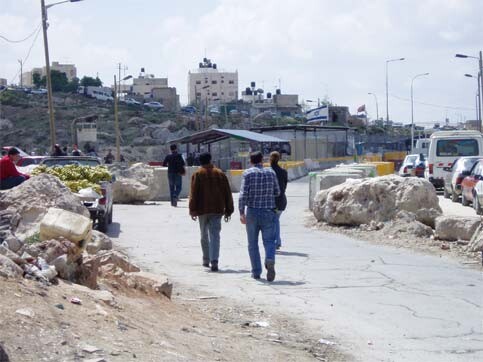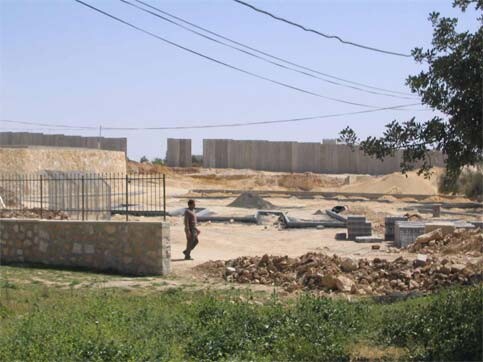When I first came to the USA for college, you would not believe my shock upon making my first Spring Break drive to Florida, some 24 hours, and realizing no one stopped us to ask for ID or inquire where we’re going. In the West Bank, during the 10-mile drive from Ramallah to Jerusalem, travelers today get stopped twice at Israeli checkpoints. Now I have seen checkpoints before, but on this last trip, the procedures at those two checkpoints were just surreal.
In the past, we used to be able to drive our own cars to Jerusalem. Now cars can rarely go through. Instead, we have to take a taxi to the first checkpoint, dismount and stand in line, then, once through, take another taxi to checkpoint #2, walk through again, then take a third taxi to Jerusalem. The taxi drivers refuse to drive through the checkpoints because they won’t earn any more money for the time spent waiting in long lines. As a result, the entire trip takes over an hour, assuming we are lucky enough to have permits. Most West Bank Palestinians don’t have those permits, even though they might need them desperately to work, study, or go to a hospital. Up until 1993, Jerusalem used to be the economic center of Palestine, many people living in Ramallah and working there. Today the Israeli closure suffocates the city and the West Bank as well.

Israeli checkpoint in Qalandia, on the Ramallah-Jerusalem road. The line of cars is visible to the right of the pedestrian walkway, and the guard tower and four Israeli soldiers to the left, just above the banana seller. (April 4, 2004)
Each checkpoint looks like a military zone, consisting of a guard tower, a pedestrian waiting area, and two car lanes: one with a long wait for Palestinian cars and a special open car lane for Israeli cars. The zones are divided by barbed wire and blocks of concrete. The whole area around the checkpoint is constantly patrolled by Israeli army Jeeps on the lookout for Palestinians trying to bypass this torture. Placement of the checkpoints can be quite arbitrary, e.g., the second checkpoint to Jerusalem is built right in the middle of a Palestinian residential area in Beit Hanina. Someone’s house stands right next to the checkpoint, with the windows of the second floor level with the guard tower. On the other side a small car dealership straddles both sides of the dividing line.
To go to Bethlehem in the West Bank, the shortest road runs through Jerusalem, but that is out of reach for most Palestinians, who usually have to endure a torturous, 4-hour ride on a dangerous mountain road halfway to the Dead Sea to get to Bethlehem. Going to Bethlehem with our permit, it was almost as difficult, the trip taking us nearly 3.5 hours. We went there on Good Friday. Soon, we found out that Israel enforces a ban on men younger than 45 years old from entering Jerusalem before 2 PM on Fridays, the Muslim day of prayer, to avoid having too many people praying at the holiest Muslim site in Palestine (the Aqsa mosque). At the second checkpoint to Jerusalem, the soldiers refused to let me in, though they said my wife can go. Never mind that I’m a Christian, never mind that we weren’t going to Jerusalem but simply passing to Bethlehem, and never mind that I have a permit which states the purpose of travel is “Christian religious holiday”. One cannot win a logical argument when the other side thinks its M-16 rifle decides the outcome.
Determined to go, we both stayed and waited, next to a growing number of Palestinians hoping like us to get into Jerusalem. Some people gave up on waiting and left with the intention of walking around the checkpoint, but others pointed to us the dangerous Israeli patrols on the side roads. That day, like nearly every Friday for the last four years, many Palestinian Muslims were denied the right to pray in Jerusalem, and this time many Palestinian Christians were denied to pray Good Friday in Jerusalem, where Jesus walked the via Dolorosa 2000 years ago. Standing there, with memories of the Baha’i Temple we visited in Haifa the day before fresh in my mind, I couldn’t help scoff at Israel’s claims to be “protectors” of religious minorities like Druze and Baha’is, while at the same time actually persecuting religious majorities like mainstream Christians and Muslims. Adding to the irony, the soldiers who stopped us at the checkpoint were Druze.
After finally letting us in, and after our third taxi ride of the day, we got to the Bethlehem checkpoint, which really was a far cry from the Ramallah-Jerusalem checkpoints. Passing the monastery of St. George (Mar Elias), halfway between Jerusalem and Bethlehem, we pass hills that once I remember used to be covered with lush pine forests and olive groves. Nowadays, however, these hills are denuded and desertified. The hill on the right - a part of the West Bank once belonging to the ancient village of Beit Jala (Biblical Gilo), is now occupied by the Zionist colony of “Gilo”, often referred to by CNN as “a neighborhood of Jerusalem”, and often the starting point for attacks on Beit Jala. On the left we see the colony of “Har Homa”, built in 1996 right in the middle of the “peace process”, while Israeli leaders were negotiating with Arafat on the return of the West Bank and demanding the privilege to annex “existing settlements” to Israel.
Worthy of note is the fact that the permanent checkpoints themselves came into being not during periods of violence but actually begun in 1993, at the beginning of the Oslo “Peace Process”. Thus rather than building bridges between people, the “peace process” brought a new level of separation between Arab and Jew. While growing up in the 1970s and 1980s, I recall frequent amiable interactions with Israelis, shopping in West Jerusalem, going to the beach in Tel Aviv, visiting Jewish family friends and seeing Israeli tourists in Ramallah. This kind of interaction was made all but impossible with the checkpoints. The generation of children growing up in the 1990s sees the other side only from behind barriers, either as children throwing stones or as fully-armed occupation soldiers or settlers. From this point of view, it is no surprise that the Oslo Process crumbled to a situation far more violent than the pre-Oslo conflicts.

The new colony of Har Homa, built just outside Bethlehem in 1996 during the Oslo Peace Process. The long pedestrian walkway in the foreground leads to the Bethlehem checkpoint, part of which is visible on the far right. The city visible in the background to the right of Har Homa is Beit Sahur, which owns the olive groves just behind the checkpoint and now annexed to the other side of the wall (April 9, 2004)
The Bethlehem checkpoint itself consisted of a huge military installation next to the road, between the two colonies. Next to it, the Ramallah checkpoint looks like an impromptu “garbage-can” roadblock. The road was blocked to vehicles, so we had to dismount, then walk down a long narrow pedestrian path parallel to the road, and surrounded by barbed wire. The path winds away from the road and around the building, passing under several surveillance cameras. On the other side, we emerge in a long tunnel, at the end of which, the soldiers wait to check our papers (twice). On the other side of the street we saw a line of about 15 young Palestinian men with their faces to a wall and their hands behind their heads. Apparently they had attempted to sneak around the checkpoint.
Emerging from this tunnel, a glimmer of tranquility shines for a few steps as we encounter vast and beautiful olive groves on both sides of the street, belonging to the cities of Beit Sahur and Beit Jala. This doesn’t last very long. Just 100 yards away from the checkpoint, we fall under the shadow of a massive section of the Apartheid wall Israel is building. On both sides of the street, the wall separates the Arab residents of Beit Jala and Beit Sahur from their olive groves, effectively annexing the fields to the colonies of Gilo and Har Homa.

A small section of Israel’s Apartheid/Annexation Wall near Bethlehem (April 9, 2004)
After spending a few hours at the Church of the Nativity in Bethlehem, we took a short ride to Beit Sahour and a monastery beyond. On the road, we encountered another huge wall under construction to enclose the Bethlehem area from the East. Returning from the monastery at sunset, we were told that the Bethlehem checkpoint closes at 6 PM, hours earlier than our permit allows us to stay in Jerusalem. The only way out of Bethlehem after that is a risky attempt to walk across the border near Beit Jala. Our taxi dropped us off there, claiming we can easily find a taxi on the other side, which would then take us to Jerusalem through the colony of Gilo. We walked across a fence and onto a dark street. An Israeli military observation post was visible to one side. We inched a few steps to avoid it, only to glimpse another tower on the other side. Dogs were howling in the dark of night, and the street was deserted, except for an Israeli military jeep on patrol. We kept walking quietly, praying the patrol won’t stop us. It was almost like attempting an escape from a high security prison. Out of the whole trip, this part perhaps was the most frightening, as I imagined soldiers shooting us, then covering it up by planting explosives on our body and presenting us as “would-be suicide bombers”. The area was so dark and remote they probably would have gotten away with it.
Finally, we found an Arabic taxicab with Israeli license plates that would take us to the Ramallah checkpoint, through the now Jewish West Jerusalem and the surrounding colonies. He was taking full advantage of the situation and charging us 4 times as much as the trip is worth. Happy to be out of there, we hopped on. The taxi took one of the new “bypass roads”, which connects the colonies on the southwest of the West Bank with Jerusalem, cutting tunnels underneath Palestinian areas of residence. Through the tunnel, then a checkpoint, we reached the neighborhoods of Katamon and Talbieh, formerly Arab areas in West Jerusalem, but depopulated in 1948. From there, the taxi got onto another bypass road, this time built on a high bridge flying above the Arab villages of al-Jib and Bir Nabala, to connect to colonies north of Jerusalem. From such a high, walled, road, there was no sign of Arab life, even though we were right on top of it, physically. Our fantasies of escaping from the high-security prison suddenly came to a screeching halt, as our driver dropped us off at the Ramallah checkpoint.
Dr. Saber Zaitoun is the pseudonym of a Palestinian-American in his thirties. Dr. Zaitoun grew up under Israeli occupation and first came to the USA during the first Intifada to finish his education. He is married, and currently teaches at a University on the East Coast. For more information about his visit to Palestine, please see www.triptopalestine.com.



